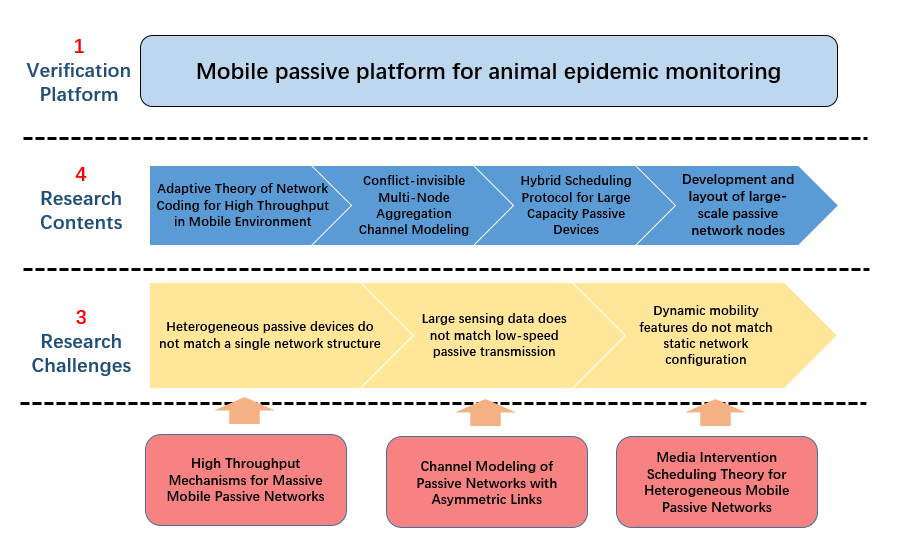Period:
2020.01-2023.12
Introduction:
In recent years, passive sensing technology has made great progress, and more and more sensor devices have changed from active to passive, freed from the shackles of batteries, so they have quickly become one of the best candidate technologies for realizing the concept of Internet of Everything. This project focuses on high-throughput mobile passive network transmission protocols and key technologies and studies the high-throughput link layer mechanism of large-scale mobile passive networks, passive network channel quality modeling under asymmetric links, and heterogeneous wireless, which are the three major scientific issues of source network media access scheduling theory. Meanwhile, it aims to solve a series of mismatches between heterogeneous passive devices and a single network structure, mismatches between large sensing data and low-speed passive transmission, and mismatches between dynamic mobility characteristics of nodes and static network settings in practical applications of mobile passive networks—a series of conflicts that need to be resolved.
Further, we explore the high-throughput network coding adaptive theory in the mobile environment, study the key technologies of multi-node aggregation channel modeling and channel estimation in the case of invisible conflicts, construct a large-capacity passive device hybrid scheduling protocol without carrier monitoring, and build a 1000-node mobile passive network prototype system for real-time animal epidemic monitoring. And we have fully verified the effectiveness and practicability of the proposed theory and key technologies, and formed a series of internationally leading research results.
Goals:
Solve a series of mismatches between heterogeneous passive devices and a single network structure, mismatches between large sensing data and low-speed passive transmission, and mismatches between dynamic mobility characteristics of nodes and static network settings in practical applications of mobile passive networks-conflicts that need to be resolved. Construct a mobile passive network system platform for real-time animal epidemic monitoring to provide scientific basis for the monitoring and prevention of animal epidemics.
The research structure of this project is as follows:

Methodology:
Adaptive Theory of Network Coding for High Throughput in Mobile Environment
The rate coding selection problem in the mobile environment is mainly divided into three steps. Initially, the real-time location information is inferred by using the physical layer information, and then the best rate is selected by using the measured signal strength and packet loss rate, and in the process of updating the mobile state. In , the adaptive adjustment of the rate coding is performed according to the real-time estimation of the mobility state.

Multi-node aggregated channel modeling and key channel estimation techniques in the case of invisible conflicts
In the above section, we assumed that the packet loss rate is known. In fact, there are many challenges in the accurate measurement of the index of packet loss rate in passive sensory networks. The research group decomposed it into three problems. Firstly, it studied how to obtain the channel packet loss rate through conflict compensation for the comprehensive packet loss rate. Then, it measured the comprehensive packet loss rate accurately by establishing linear constraints. Finally, it studied how to use the channel correlation performance to achieve lightweight channel detection.
Hybrid Scheduling Protocol for Large Capacity Passive Devices Without Carrier Sense
After completing the channel estimation and rate coding selection issues, this project also needs to study another fundamental issue in the rate adaptation framework, access control scheduling. The access control problem of passive sensory networks becomes very special because passive nodes cannot perform carrier sense. In order to deal with the problem of too slow scheduling efficiency of large-scale passive sensing network, the research group will optimize from two aspects, 1) learn from the idea of distributed database SQL query, and improve the access efficiency through the method of group scheduling; 2) for wireless According to the transmission requirements of source-aware big data, a corresponding continuous transmission strategy is established.
Typical application of large-scale mobile passive network in real-time animal epidemic monitoring
Construct a mobile passive network system platform for real-time animal epidemic monitoring to provide scientific basis for the monitoring and prevention of animal epidemics.
